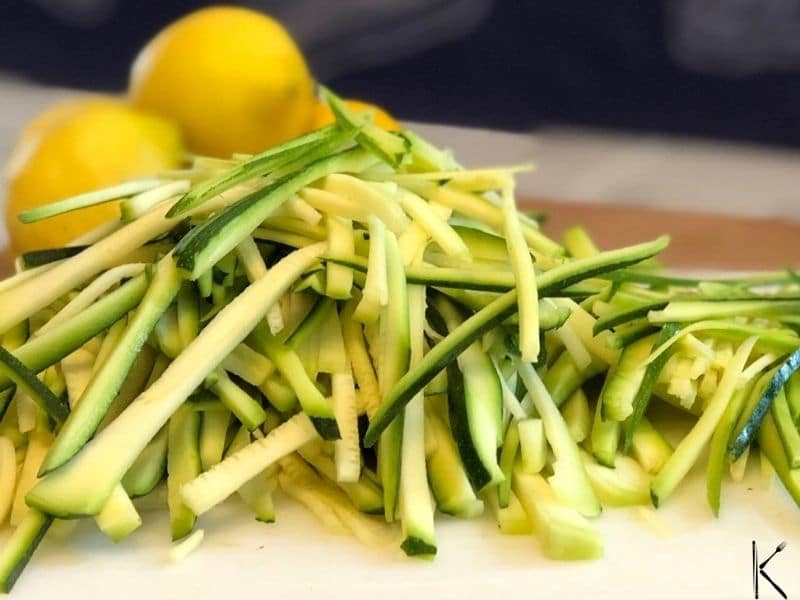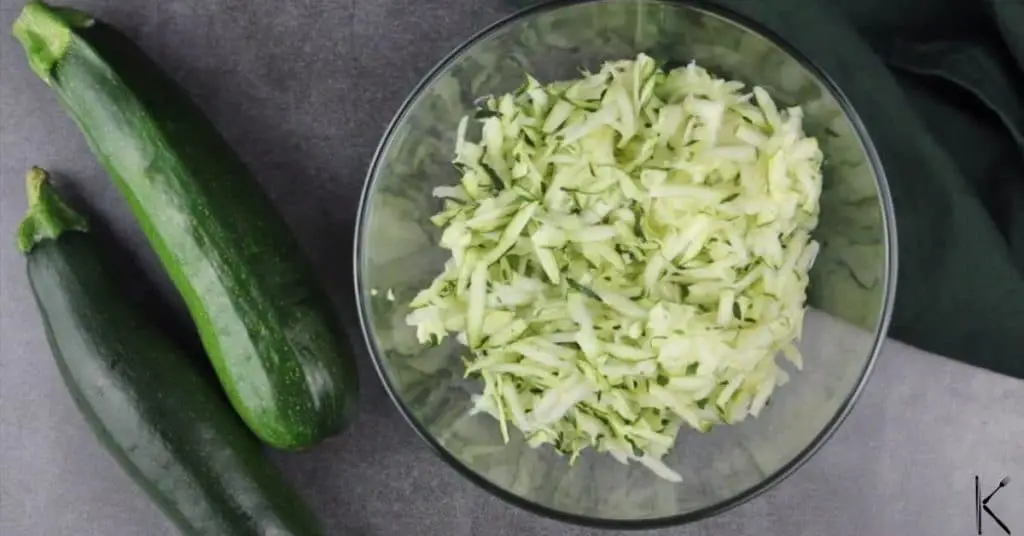Briefly, yes, you can freeze zucchini, but it requires pre-treatment to remove excess moisture. Either use the salt-rub preparation or blanching method before freezing to preserve texture and flavor.
Zucchini doesn’t get the credit it deserves. This underrated vegetable is incredibly versatile. Besides being eaten steamed, pan fried, or roasted in olive oil, it can be baked into muffins, zucchini bread, pancakes, pizza, and quiche. Making zoodles is also a healthy, low calorie, low card pasta alternative
From zucchini fries to zucchini salad, this is a great vegetable to have on hand at any time.
Being a moisture-rich vegetable, zucchini does not have a long shelf life, and once cut, it starts to spoil quickly. Despite being sensitive to changes in temperature, zucchini can be frozen, however, certain steps will need to be followed to avoid it from turning into a mush mess once thawed.
Here is a full guide to successfully freeze zucchini noodles.
Can Zucchini Noodles Be Frozen?
Yes, you can freeze zucchini noodles, however, it is not as simple as just chopping it and placing it in the freezer. Fresh zucchini contains a lot of moisture. Zucchini noodles that have not been properly treated for the freezing process will become a soggy mess once thawed.
When you freeze zoodles, it is essential to protect the vegetables from contact with excess air and moisture. To prevent freezer burn, pat them completely dry before freezing and keep them in airtight packaging.
There are 2 ways to pre-treat zucchini for freezing.
- The salt-rub preparation method aims to get rid of as much moisture as possible prior to storing zoodles in the freezer. This is used to ensure that the thawed noodles hold their shape and texture, with loads of flavor.
- Blanching kills the active enzymes in the vegetable which causes gradual loss of flavor, texture, and color. This method is best used for freezing chopped and sliced zucchini. This will prolong the shelf life of extra zucchini especially if you are planning to freeze it for longer than 2 or 3 months.

Follow the steps below for the best results when freezing raw zucchini noodles or chopped zucchini.
How To Freeze Zucchini
Step 1: Clean and Cut
Before you even start the freezing preparation process, make sure you choose zucchini that is fresh, firm, and has no blemishes or soft spots. Wash the zucchini and cut off the ends. Spiralize, peel, or slice the zucchini into the desired shape and size.
Use the preparation method below depending on how you have cut the zucchini
Method 1: Blanch Zucchini Noodles or Slices
Step 2: Blanch
Bring a large pot of unsalted water to a boil on the stovetop. At the same time, prepare a separate bowl with ice cubes and cold water to make an ice bath.
Place the chopped zucchini in the boiling water for 2 to 4 minutes depending on the size of the slices. If you are blanching fresh zucchini noodles, 2 minutes is enough time. Chunkier pieces will require more time.
Step 3: Cool and Dry
Immediately remove the strips and place them in a large bowl of ice water to stop the cooking process. The zucchini should still have a firm texture and not be cooked through.
Once the zucchini is completely cool, remove it from the ice bath with a slotted spoon. Place it on a clean, dry dishtowel or paper towel and pat the zoodles dry to remove any excess water.
Step 4: Flash Freeze
To prevent the zucchini pieces from sticking together when freezing, spread them out in a single layer on a baking sheet lined with parchment paper. Place the baking tray in the freezer just until the pieces are frozen.
Once frozen, remove the tray from the freezer and move onto Step 5 below, working quickly so that the zucchini does not start to defrost.
Method 2: Zucchini Noodle Salt-rub
Step 2: Salt
Place the shredded zucchini in a large bowl. Using one tablespoon of kosher salt for every 2 cups of zucchini, sprinkle the salt over the zucchini in the mixing bowl and gently mix the salt through the entire batch making sure that everything is well coated. Add salt if more is necessary to coat everything.

Step 3: Drain
As you lightly rub the salt throughout the spiralized zucchini, moisture will be released and bubbles will appear. Once you are certain the salt is fully mixed throughout the entire batch, place the zucchini in a colander lined with a clean, thin cloth.
Let the colander or strainer basket sit for an hour over the sink to allow all the moisture to drain.
Step 4: Dry
Form a cloth bag by gathering the edges of the cloth together at the top, holding the batch of zucchini in the center. Squeeze lightly to remove excess moisture from the zucchini.
If the cloth is too wet, use a fresh cloth. You need to ensure all the excess moisture is pressed out and that liquid stops dripping from the cloth entirely. Complete the drying process by letting the zucchini sit on the cloth or on paper towels to air dry for a while.
Step 5: Portion and Pack
Regardless of whether you have prepared slices or noodles, divide the zucchini into the portion sizes you may want to defrost at any given time. Pack each portion into a separate resealable freezer bag. Alternatively, you can also use an airtight container.
Doing this allows you to only defrost a single portion at a time without having to thaw an entire large batch and not being able to use it all. Smaller portions also allow for better preservation of the texture during freezing.
Step 6: Seal
Lie the bag flat on the counter and press out as much air as you can before sealing it.
Step 7: Label and Freeze
Label the freezer bags with the date of freezing to keep track of the freezer storage time and place it in the freezer.
How To Thaw Frozen Zucchini
You don’t need to defrost zoodles when used in cooked dishes such as soups, stews, and stir fries. Remove the frozen zoodles or zucchini pieces straight from the freezer and boil it on the stovetop or add to your pan to pan-fry.
When baking with zucchini, it is best to thaw it first to prevent the liquid that is released on thawing from changing the consistency of the batter. Put the bag of frozen zucchini in a bowl to catch the water while thawing. Place it in the refrigerator for a few hours to defrost.
Alternatively, to defrost zoodles quickly, place the bag in a bowl of water. Drain and lightly squeeze out excess liquid from the defrosted zucchini before adding it to your batter.
Types of Zucchini

Zucchini is a type of summer squash also commonly called courgette, marrow, or baby marrow. The long green vegetable is harvested when immature at about 15 to 25 cm long, although it can grow longer. The thin skin is edible and generally left on when cooked.
On cooking, zucchini softens significantly. Zucchini can be baked, stuffed, fried, steamed, boiled, sauteed, crumbed, and even turned into spiralized noodles, also known as zoodles. Spiralized zucchini makes a great gluten free replacement in pasta dishes.
FAQs
Conclusion
Zucchini noodles are a delicious good-for-you pasta substitute. Not only can they be used in place of spaghetti or lasagna, but they make for a great addition to Pad Thai, pho, and stir-fry. Zucchini can also be used in cold salads tossed with a dressing or as a side vegetable dish.
Regardless of whether you are planning to use your zucchini as noodles, for baking, or adding to a stew, freezing is a handy way to prolong the vegetable’s short shelf life and reduce prep time later.
The best part is that zucchini does not need to be thawed before cooking, so you can literally pull your zucchini out of the freezer and place it on the stovetop for cooking for a quick-fix, healthy, and delicious meal! Eating healthy has never been so convenient.
Up next: How to freeze butternut squash









